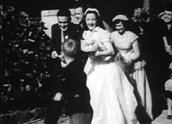

The Bones of Building (1956)
Synopsis
This is an instructional documentary made by the Waterside Workers’ Federation Film Unit on safety in the construction industry. It dramatises the case of Bill Smith (Dick Hackett) to illustrate how dangerous accidents can occur on building sites if workers do not observe safety regulations. It highlights the role of the union in both working to prevent accidents in the workplace and fighting for compensation if they occur.
Curator’s notes
The Bones of Building was commissioned by the Building Workers’ Industrial Union and was the WWF Film Unit’s first film made for another union. It is essentially a safety film for building workers; construction work was becoming increasingly dangerous at the time following the shift in building priorities from postwar homes to high-rise and commercial sites. The film emphasises the worker’s role in ensuring that conditions are safe, and that it is not just the responsibility of the site owners. This moral obligation is strongly conveyed through the story of Bill Smith (played by wharfie Dick Hackett, who also appeared in The Hungry Miles, 1955, and wrote music for Not Only the Need, 1958). By depicting a believable scenario that a building worker could relate to, the film shows the devastating consequences of 'one small slip’ that could have easily been avoided.
The film shows Smith’s fate early on, setting up a tension in the following scenes. In flashback, Smith arrives back from a stint in the army, marries his sweetheart and starts a family (see clip one). His job building small cottages in the postwar boom sustains him and his family until the market shifts and he is forced to find employment on a large construction site (see clip two). This is where the trouble starts.
The foreman on the site (played by one of the film’s directors, Jock Levy) convinces Smith that the Scaffolding Act is 'just so much red tape’ and that the scaffolding he is working on is safe. Grudgingly Smith agrees, but when the scaffolding gives way and he tumbles to the ground, it is Smith who must pay the consequences for the rest of his life. These consequences extend beyond the physical injury to encompass his whole family. Now in a wheelchair, Smith is wheeled out into the back garden by his wife and positioned next to his young son crying in a pram. Leonard Teale’s convincing and dramatic voice-over narration pushes the point home, 'he still has a lot of memories, but not much future’. Instead of climbing the scaffold, Smith could have refused and called in the union to fight his case.
The Waterside Workers’ Federation Film Unit was formed in 1953 when Jerome 'Jock’ Levy, Keith Gow and Norma Disher made Pensions for Veterans (1953) as part of the wharfies’ campaign to win pensions for veteran waterside workers. The success of their films prompted other unions to commission work from them and the unit made around a dozen films for the WWF as well as the Building Workers’ Industrial Union, the Miners’ Federation and the Boilermakers’ Union. Together these films represent a unique audiovisual record of labour history in Australia told from the point of view of the workers.
Fighting Films: A History of the WWF Film Unit (2003, Pluto Press) was written by academic Lisa Milner based on her PhD research into the WWF Film Unit. The book was jointly funded by the Maritime Union of Australia, the Construction Forestry Mining Energy Union (Mining and Construction Divisions) and the Australian Manufacturing Workers’ Union. To coincide with the publication, the MUA released a three-DVD compilation featuring 13 of the WWF Unit’s films as well as John Hughes’s documentary Film-work (1981).
The Bones of Building had its first public screening in March 1956. It was shown at union, delegates and training meetings as well as on building sites to thousands of BWIU workers. It also screened to members of other unions including the Waterside Workers’ Federation and Builders Labourers’ Foundation. It featured in the 1956 Melbourne Film Festival and toured the country as part of the ACTU’s inaugural National Safety Week in 1957.
- Overview
- Curator’s notes
- Video 2 clips

- Principal credits
- Find a copy
- Make a comment
- Add your review



